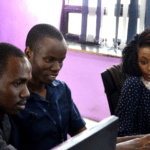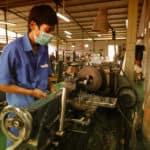The New Face of Poverty: Why Unemployment isn’t the Issue – And How Financial Inclusion Can Help
When you think about poverty, what does it look like? Perhaps a particular country, situation or archetypal character comes to mind – maybe an undernourished African child, or an elderly beggar sitting in the street. These images may be similar to what the person next to you imagines – but they may also be a far cry from the typical reality of poverty in today’s world.
This is not to say that these depictions are wrong, it is more to point out that the extreme deprivation that typically dominates news agendas is actually shrinking, and no longer represents the growing face of poverty. For example, take the receptionist who took your call today, or the mechanic who fixed your car – could they possibly be in a state of poverty? The fact that these individuals are working actually tells us little about their true financial status. That’s because, when it comes to measuring poverty, both emerging and developed markets face their own unique challenges – and wages aren’t enough to provide a true measure.
The Face of International Poverty
In the U.K., there has been a common misconception that the poverty crisis can be solved through work, in spite of a reduction in welfare contributions and/or government benefits transfers. So how can we explain that the unemployment rate is at 4.0 percent, while 14 million people live in poverty – over one fifth of the population. Research by Cardiff University showed the poverty risk for adults in working households in the U.K. rose by 26.5 percent over the last decade. By 2015, 60 percent of people living in poverty were in working households – the highest figure yet recorded. Poverty has permeated the working and middle class in the country, and its primary cause is financial insecurity.
In the U.S., according to Professor Philip Alston, United Nations Special Rapporteur on extreme poverty and human rights, 40 million people live in poverty – equal to 12.7 percent of the population – and almost half of those (18.5 million) live in deep poverty, with income below one half of the poverty threshold. Yet, similar to the U.K., the unemployment rate stands at just 3.7 percent. Many workers at Walmart and other large, low-cost retailers are reliant on food stamps, requiring an estimated $6 billion dollars from the Supplemental Nutrition Assistance Program to support these workers.
For emerging markets, the situation is similar – but significantly worse. In sub-Saharan Africa, the average unemployment rate is 7.3 percent, and this reaches as high as 27 percent in South Africa and Lesotho and 26 percent in Eswatini (according to the World Bank). Yet poverty rates are much higher than unemployment rates, with 619 million people – 65 percent of the population – living in poverty (less than $3.10 per day) and 389 million people – 41 percent of the population – living in extreme poverty (less than $1.90 per day). Interestingly, in Latin America and the Caribbean, the average unemployment rate is higher than in sub-Saharan Africa at 8.7 percent, but levels do not reach as high in individual nations, with countries such as Brazil and Jamaica leading the region at 12.8 and 11.7 percent respectively (World Bank). And as in Africa, the level of poverty far exceeds unemployment, at 30.7 percent (186 million people in 2016), with 10 percent (61 million people) in extreme poverty.
The Emergence of the Working Poor
It’s clear from these numbers that employment alone is not sufficient to keep people out of poverty, but why is this the case? In Western countries like the U.K. and U.S., there are several reasons:
- Since the Great Recession, jobs that used to provide pride, a good life and long-term economic security – for example in manufacturing – have been replaced by zero-hour contracts in the service sector, and the kinds of “gig economy,” pay-per-task jobs that are the hallmark of the modern working poor. These new jobs do not provide any of the financial security that was part and parcel of the former blue-collar employment contract;
- When public debt was expanded after the financial crisis, many welfare systems faced systematic challenges. Exposure to poverty is now shared by many who are only “one shock away” – for example, a medical bill, a funeral, a divorce – from joining the ranks of the poor;
- Particularly in the U.S., the poor live around the corner from extreme wealth, adding the psychological pressure of low self-esteem, and the temptation to keep up appearances through conspicuous consumption – which can lead to unsustainable expenditures and debt.
For emerging countries such as those in Latin America and Africa, there are different factors at play, including:
- A lack of well-paid jobs, especially those that generate a reliable and steady income. In sub-Saharan Africa, the employment figures also include 59 million children between the ages of 5 and 17 who need to work instead of enjoying their childhood and going to school.
- There is still great inequality and poor education, preventing the general population from gaining access to good jobs.
- The poor live in poor communities and the rich stay in rich communities. This makes it nearly impossible for those who are born poor to work their way out of poverty.
A New Measure of Poverty
Since the Great Recession and the subsequent rise in inequality, poverty has increasingly been driving political upheaval, regulation and general challenges to public policy worldwide. But in this age of the working poor, a more reliable measure of poverty in our current world is access: to clean water, to power, to basic education, to reliable public services like health and so on. All of these are traditional areas of study in the world of poverty alleviation. However, a new one is now emerging: access to the internet, an increasingly essential part of a country’s core infrastructure that can be leveraged to deliver many of the above services, including education, health screening, technical training, market data, payments and other financial services, and more. The power of the internet and the data it generates can be leveraged to help tackle the new problems of poverty – particularly by enabling financial access that can give poor people the tools to boost their incomes, budget and save more effectively and send money to loved ones. But this is not without its challenges.
For villagers of Utsjoki, a remote village in Finland with just 1,000 inhabitants, fast internet services can be accessed for as little as £7 per month. And across the U.K., 91 percent of households have access to broadband. That is why U.K. fintechs are leveraging digital apps and channels as cost-effective and scalable ways to improve financial inclusion. However, this isn’t as simple for other regions. In West Virginia, for example, despite residing in an affluent Western country, an estimated 30 percent of people lack access to high-speed broadband (compared to 10 percent nationally) – with 48 percent of rural West Virginians lacking access (compared to 39 percent of the rural population nationally).
The numbers are much worse in many emerging countries. Across Sub-Saharan Africa, countries have some of the lowest numbers of internet users, and the most underdeveloped telecommunications infrastructures with the greatest connectivity issues in the world. In the Democratic Republic of Congo (DRC), for instance, only 3.9 percent of the population have access to internet services, along with 2.4 percent in Sierra Leone and 4.2 percent in Ethiopia. Nigeria stands as one of the most connected countries in the region, yet just 46.1 percent have access. Lack of infrastructure is to blame here – for example, Malawi and DRC have one of the lowest rates of electrification in the world at just 11 percent and 17.14 percent respectively. For countries like Brazil, the situation is more promising, with 66.4 percent of inhabitants having access to internet services. Clearly though, there is still a long way to go.
Tackling Poverty with Technology
What’s the best way forward? As with the problem of poverty itself, the solution depends largely on the context: Some countries like the U.S. and U.K. have financial infrastructure catered to the middle class – for example, the cost of credit for small loans is much higher than larger ones, due to the high cost-to-serve ratio. Countries in emerging markets however, often have little to no infrastructure at all. For example, according to an IMF report, in Sub-Saharan Africa the scale of financial intermediation and access to financial services is significantly and relatively lower than developed regions, whilst banks themselves are often small and characterised by low loan-to-deposit ratios. What’s more, the report argues that lending is often short-term in nature, and banks are typically high-cost operations with branches concentrated in a select few urban centers.
Instead of trying to create a traditional financial infrastructure, then, a better method for these countries is to leverage the power of technology to make financial services cheap and accessible, anywhere and for anyone. That’s why one effective way to combat poverty in its present form is to focus on improving access to internet services for countries that lack it, while increasing the use of technology for financial access, enabling affordable microcredit, digital identities, better access to financial education and so on.
In a strange historical twist, entrepreneurs and social problem solvers find themselves in an interesting position, in which creating a new tech-centered infrastructure is actually easier than developing a traditional, financial one. For instance, implementing the infrastructure needed for greater bandwidth and access to data in areas like the DRC is less expensive than (re)building the entire banking ecosystem. Only two kits are required to place someone on the financial grid – a smartphone and a telecommunications tower. The former may seem like an unattainable cost, but global smartphone penetration is accelerating access and driving down cost, with entry-level smartphones now available for well under $100.
For the West, technology can also provide an answer to the systemic issue of poverty. Financial services providers can assess risk using alternative data that analyzes individual circumstances, as opposed to a traditional credit bureau. This may take the form of qualitative, psychometric testing to assess individual needs, expand access to credit and other services, and break the cycle of poverty. Through data and technology, we can also ensure that this journey does not end with access, but that individuals can utilise their data to become active players within the financial system: They can engage in building their credit history and take more control of their financial management.
The first step in this process involves acknowledging that access to employment is not enough to combat the world’s poverty crisis. We need to focus more efforts on leveraging technological solutions to provide better access to finance and education. This, in turn, will kick-start business and entrepreneurial economies and ensure that more people not only have access to meaningful work, but also have the capability to avoid poverty by having more control over their finances. By giving customers the power to shape their own financial futures, both emerging and developed countries can strike a blow against the new reality of poverty.
Frederic Nze is the founder and CEO of Oakam.
Photo courtesy of Institute for Money, Technology and Financial Inclusion.
- Categories
- Finance, Telecommunications



